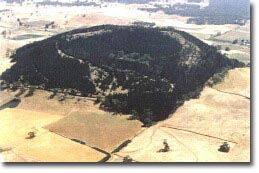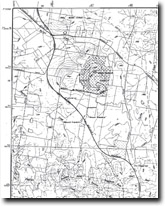Mt Franklin
|
This information has been obtained from the report: Eruption Points of the Newer Volcanic Province of Victoria by Neville Rosengren. This report was published in 1994 and was prepared for the National Trust of Australia (Victoria) and the Geological Society of Australia (Victorian Division). The review of eruption points was based on an earlier unpublished manuscript Catalogue of the post-Miocene volcanoes of Victoria compiled by O P Singleton and E B Joyce (Geology Department, University of Melbourne 1970). |
| 37 16 00S 144 09 00E (external link); 7723-3-1 (Daylesford) 471720. 9 km N of Daylesford. Daylesford-Castlemaine Road, |  Mt Franklin breached crater | |
Daylesford and Glenlyon. | ||
Public land. Road access to crater, upper area pine plantation, lower slopes native woodland. Surrounded by private land. Exposures in road cuttings. | ||
Type 5: | Scoria cone with breached crater. | |
Mount Franklin is a prominent, conical scoria cone with deep crater open via a narrow breach in the rim on the southeastern side. The breached rim is probably a result of a late-stage lava flow breaking through the lower part of the cone. Earlier flows extend to the north and west. The coarse ejecta exposed around the summit includes red and green olivine and megacrysts of high-temperature and orthoclase (to 7 cm long) and augite (over 9 cm long). Lumps of Ordovician sedimentary and granitic bedrock also occur in the ejecta and small basalt blocks contain cores of crazed quartz. On the western slope is the parasitic scoria mound known as Lady Franklin (Unnamed CN5). | ||
635 m; 185 m. | ||
State: | This is a large and very obvious example of a breached scoria cone. The crater is one of the deepest in the Central Highlands area. It is a major megacryst site with some of the largest known Victorian examples of megacrysts of augite and an orthoclase. The small parasitic mound of Lady Franklin on the western flanks adds to the geological interest of the site. | |
References: | Edwards, A.B. (1938). The Tertiary volcanic rocks of central Victoria. Quarterly Journal of the Geological Society of London 94, pp. 243-230. Hills, 1940; Coulson 1954; Ollier 1967a; Beasley 1970. | |

Mount Franklin 7723-3-1 (DAYLESFORD)


